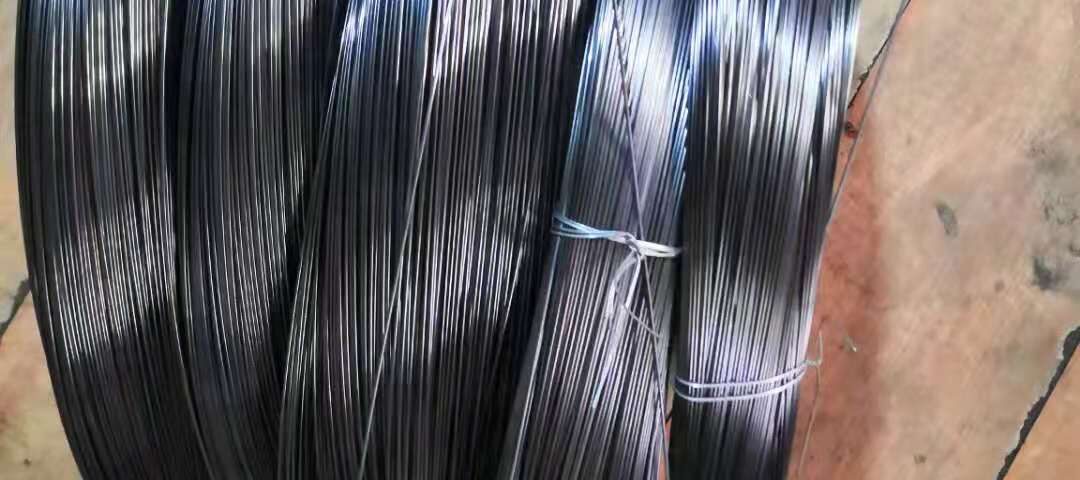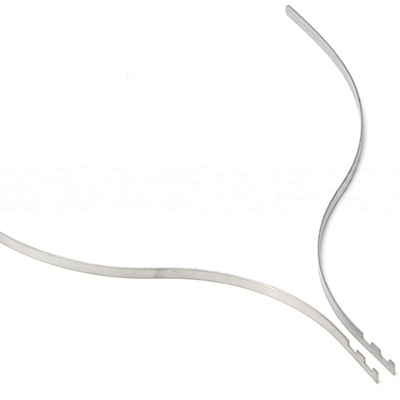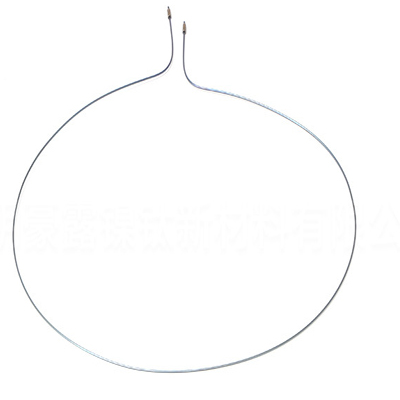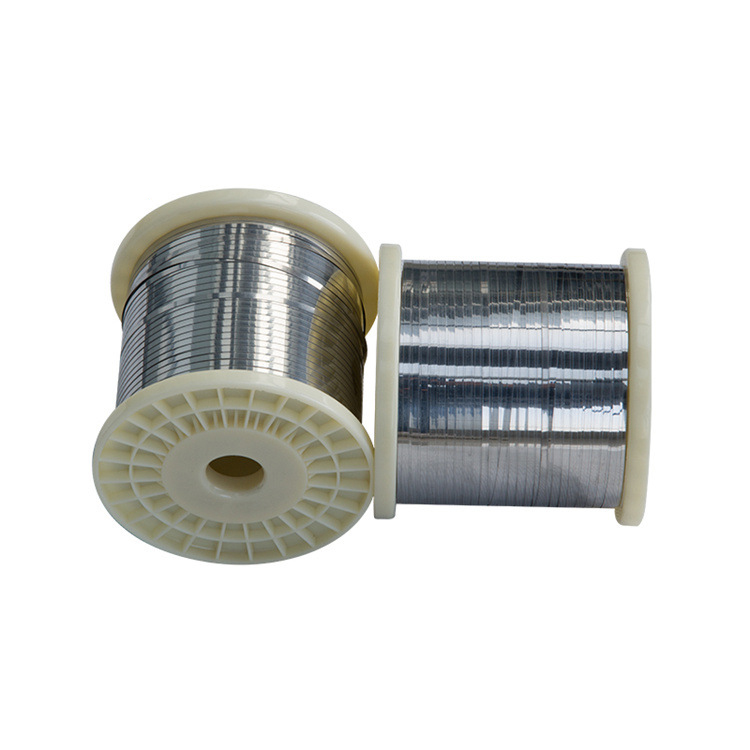
What are the important parameters of Nitinol tube?
27 5 月, 2021
Is Nitinol a biomaterial?
27 8 月, 2021(Shape Memory Alloy referred to as SMA) refers to the alloy having a certain initial shape at low temperatures after plastic deformation and fixed into another shape, by heating to a certain critical temperature above and can be restored to the initial shape of a class of alloys.
1.Characteristics of shape memory alloys
- Shape memory effect: Shape memory alloy has the ability to restore shape after proper heat treatment,this ability is called Shape memory effect(Shape memory effect referred to as SME).Shape memory effect is divided into one-way shape memory effect, two-way shape memory effect and full-course shape memory effect according to the recovery situation.
- Superelastic effect: Shape memory alloy deformation occurs when the external force, after the removal of the external force will be restored to its original state, this phenomenon is called superelasticity.In the event of super-elastic deformation of the shape and alloy, the martensite phase change is induced. After the external force is removed, the martensite reverse phase change occurs.
- Damping characteristics: Shape memory alloy has good damping characteristics due to the self-coordination of martensite phase transition and various interfacial and interfacial movements formed in martensite.
- Resistance characteristics: Studies show that for Ni-Ti alloys with initial structure martensite, the resistance to strain during the stretching process showed a linear relationship;for Ni-Ti alloys with initial structure austenite or austenite and martensite mixed, when the stress-induced martensite phase transition occurs, the slope of the curve decreases,and the resistance-strain relationship before and after the phase transition remains linear.
2.Research Progress on Shape Memory Alloys
The shape memory effect was first discovered in 1932 by Olander in his study of Au-Cd alloys.In 1963, the U.S. Naval Weapons Laboratory Buehler(Buehler)and others found that nitinol alloy has a shape memory effect.Cu-Al-Ni was also found to have this effect in 1964.Since the 1970s, scientists have discovered this effect in 304 austenitic stainless steel and Fe-18.5 Mn.
In 1969, Raychem of the United States produced Ti-Ni-Fe memory alloy pipe fittings for the connection of hydraulic piping systems on F14 fighter aircraft, which was the first successful application of SMA.In 1970, the United States made nitinol memory alloy wire into a spacecraft antenna.The former Soviet Union began systematic research on shape memory alloys in 1969.Germany began to explore the mechanism and application of shape memory effect in 1971, and claimed to have a successful product in 1976.Japan also actively conducted research in this area in the 1970s.In the 1970s, countries have developed Ni-Ti-based, Cu-Al-Ni-based and Cu-Zn-Al-based shape memory alloys.In the 1980s, Fe-Mn-Si-based, stainless steel-based and other iron-based shape memory alloys were developed.From the 1990s to the present,high temperature shape memory alloy, wide hysteresis and alloy film have become hot research.The research and application of shape memory alloys in the United States, Japan and other countries have been more mature, and the industrialization of shape memory alloys has been achieved earlier.
In terms of material metallurgy, especially the refining level of practical shape memory alloy has been recognized by the international academic community, and there are some unique achievements in the application and development.As the pioneer of nitinol in China, Pell Technology specializes in the research and production of nitinol materials. The engineering team composed of several Ph. D. and Master’s degrees in materials science has been aiming to push China’s high-end nitinol materials to the world, constantly learning and innovating, improving technology, and gradually shortening the gap between the industrialization and engineering applications of shape memory alloys and foreign countries.
3.Classification of shape memory alloys
So far, the shape memory alloys that have been developed are mainly Ti-Ni-based, Cu-based and Fe-based.In these three categories, according to different requirements and working environment, respectively, adding and adjusting the amount of some alloying elements in the matrix, so that each category has a series of alloys have been developed, used in all walks of life, has met a variety of different special needs.
Titanium-nickel shape memory alloy developed at the earliest, the shape memory effect is the most stable, relatively mature, has been applied in the aerospace industry, automotive industry, electronics industry, medicine and human life.However, due to its raw materials Ni, Ti is expensive, and high processing cost factors, its application is limited.
4.Application of shape memory alloys
Since the shape memory alloy in addition to having a unique shape memory function but also has superelastic, high damping, wear resistance and corrosion resistance, etc., it is widely used in many fields such as machinery, construction, aerospace, automotive and medical.
- Mechanical engineering
The earliest applications were in pipe fittings and fasteners.At the connection of mechanical parts,the connection of pipes,the interface of air refueling of aircraft,the shape-memory alloy is processed into a casing with an inner diameter of 4% smaller than the outer diameter of the pipe to be connected, and then the casing is expanded to about 8% at a liquid nitrogen temperature, the casing is removed from the liquid nitrogen during assembly, and the pipe to be connected is inserted from both ends.When the temperature is raised to room temperature, the use of electric heating to change the temperature, the interface and the alloy deformation, casing casing shrinkage is formed to tighten the seal, so that the buckle precision drip (oil) does not leak, far better than welding, especially suitable for aviation, aerospace, nuclear industry and ships and submarine oil pipelines.In some parts of the construction inconvenience, the pin is made of memory alloy, heated into the hole, and the tail end is automatically curled separately to achieve fastening.The use of memory alloy temperature-sensitive drive dual function, the production of robots, manipulators, small size, compact structure.
- Construction works
Shape memory alloy has superelastic properties and high damping characteristics, the structure containing shape memory alloy can significantly increase the system damping, reduce the dynamic reaction of the structure, you can use it to make various forms of damping energy-consuming devices.You can also use the shape memory alloy design isolator, its working principle is that the shape memory alloy device will produce a large deformation displacement energy consumption after deformation, reducing the transmission of seismic energy to the upper structure of the lower structure, so as to achieve the purpose of protecting the superstructure, improve the seismic performance of the structure.
- Aerospace industry
An average of 800 shape-memory alloy joints are used in the hydraulic system of an American F-14 aircraft.Hundreds of thousands of such fittings have been used on U.S. Navy aircraft since 1970, and there has been no record of a failure.In addition to making pipe joints, shape memory alloys are also used in spacecraft antennas, fasteners, connecting parts, electrical connections and electromechanical actuators.
- The automotive industry
It is used for the shape memory spring of engine heatproof fan clutch, exhaust automatic adjustment nozzle, automatic switch of diesel engine radiator hole and jet engine pumping filter.
- Medical devices
Shape memory alloys have been widely used in the medical field because of their good mechanical properties and biocompatibility.In particular, NiTi shape memory alloy, its good superelasticity and shape memory effect has been successfully applied to oral teeth correction, surgical correction and plastic surgery and cardiovascular minimally invasive interventional treatment.Thrombosis filter is also a new product of memory alloy.When the straightened filter is implanted in the vein, it gradually reverts to a mesh, preventing 95% of the clotting mass from flowing to the heart and lungs.Has entered the medical clinical trials as well as surgical sutures,dental orthopedic silk, brain aneurysm clip, intramedullary nail, artificial joints,contraceptive ring, artificial heart, artificial kidney with miniature pump and so on.
5.The development trend of shape memory alloys
- High temperature shape memory alloy
Both NiTi and CuZnAl alloys can only be used below 100 ° C.But in quite a few cases, such as fire protection devices, the operating temperature of the memory alloy element of the car engine are more than 100℃.In the nuclear reactor project, the operating temperature of the memory alloy thermodynamic element is as high as 600℃, so the development of high temperature shape memory alloy has become a major development direction.High temperature shape memory alloy has a very broad application prospect in the high temperature field such as thermal drive, relay and nuclear industry.
- Magnetic shape memory alloy
Magnetic shape memory alloy can output a large strain under the action of a magnetic field, while the operating frequency of the memory alloy from about 1Hz temperature-controlled state(TiNi memory alloy film thermal drive operating frequency of up to 100Hz), increased to more than 300Hz magnetron state.Using these functional characteristics of magnetic drive memory alloy, the sensor and drive components made have important application prospects in petroleum, electronics and aerospace and other industrial fields.
In addition to the above, there are wide hysteresis shape memory alloy, narrow hysteresis shape memory alloy, shape memory alloy film, high yield limited shape memory alloy, low stress hyster.




